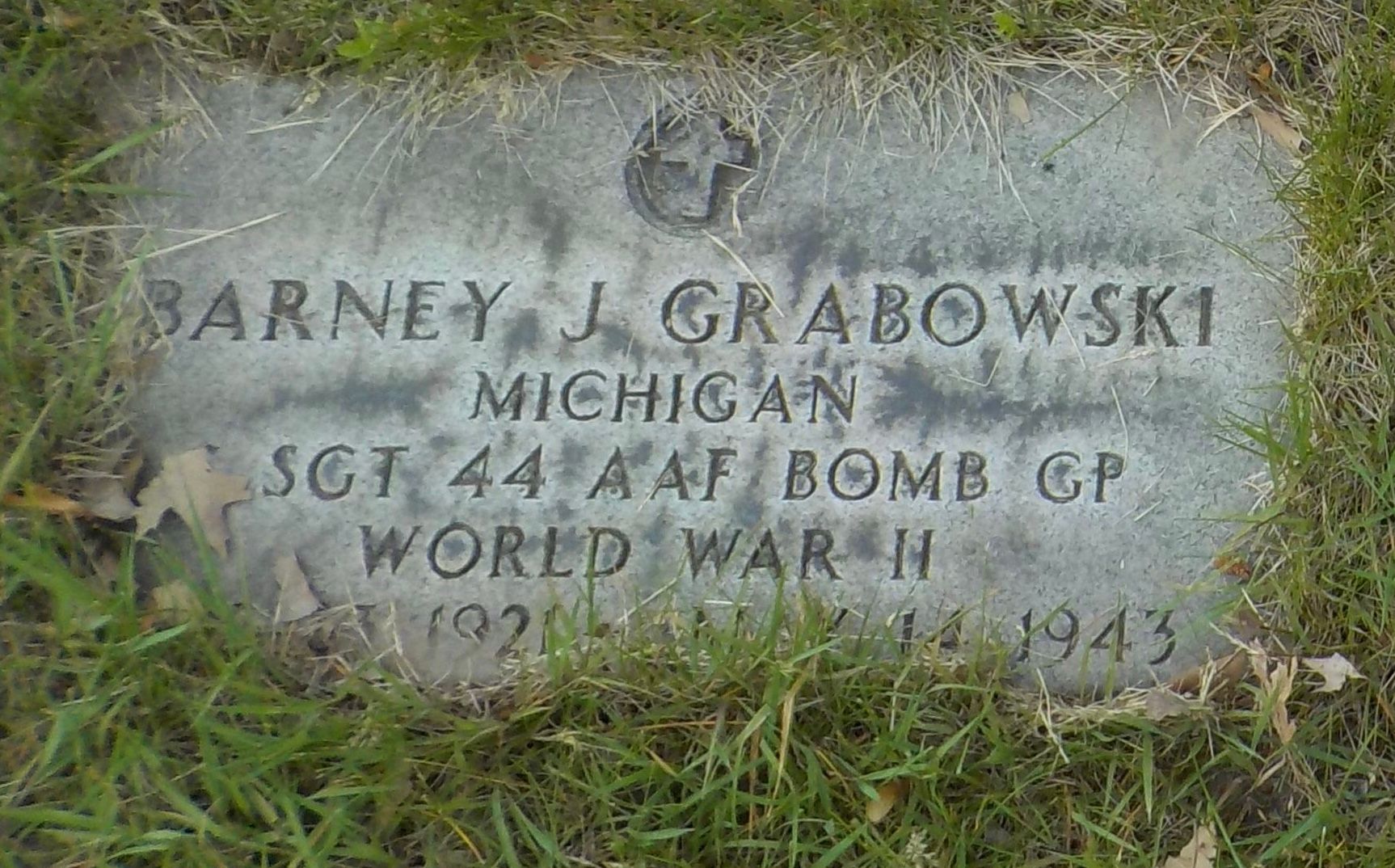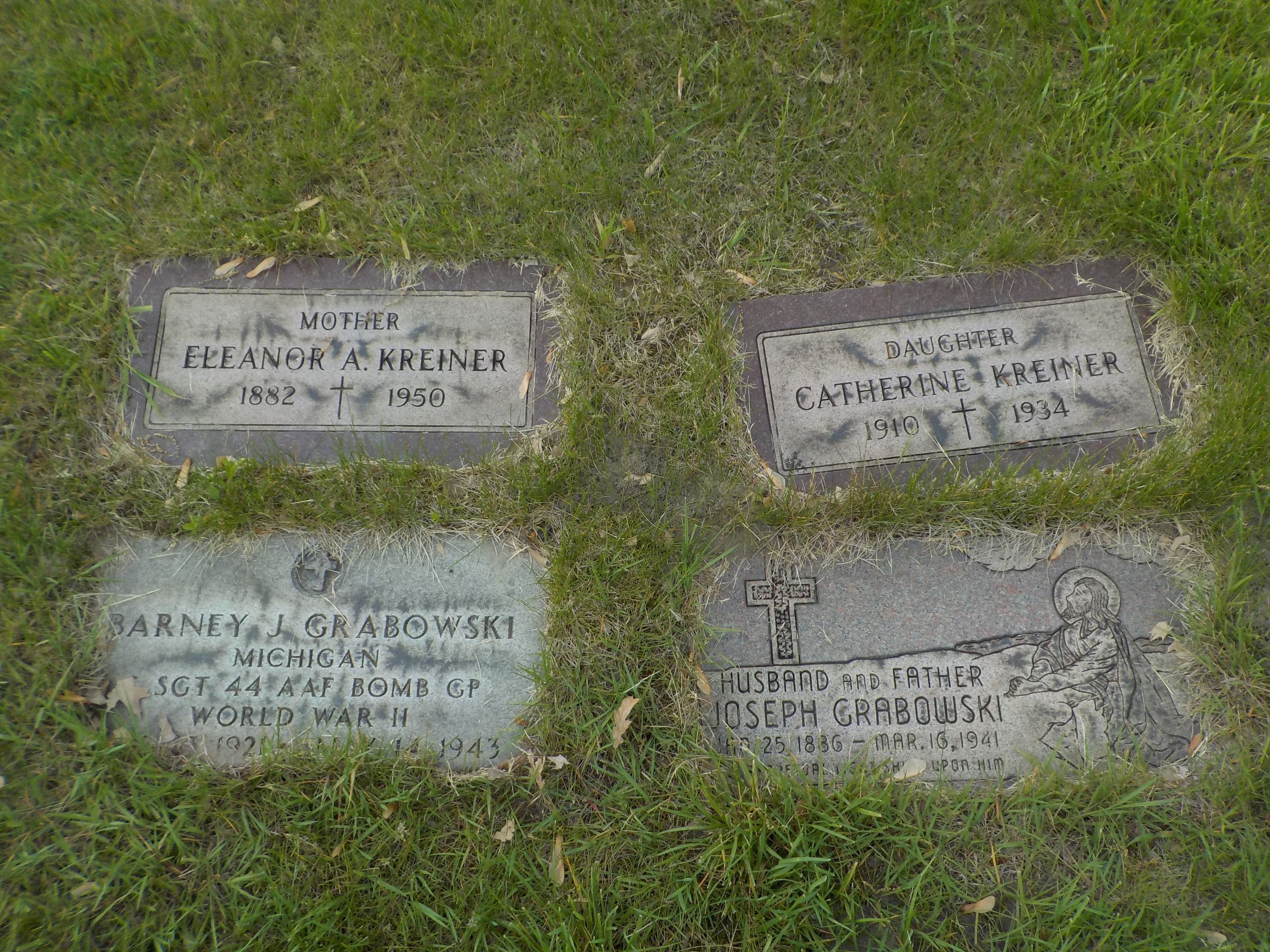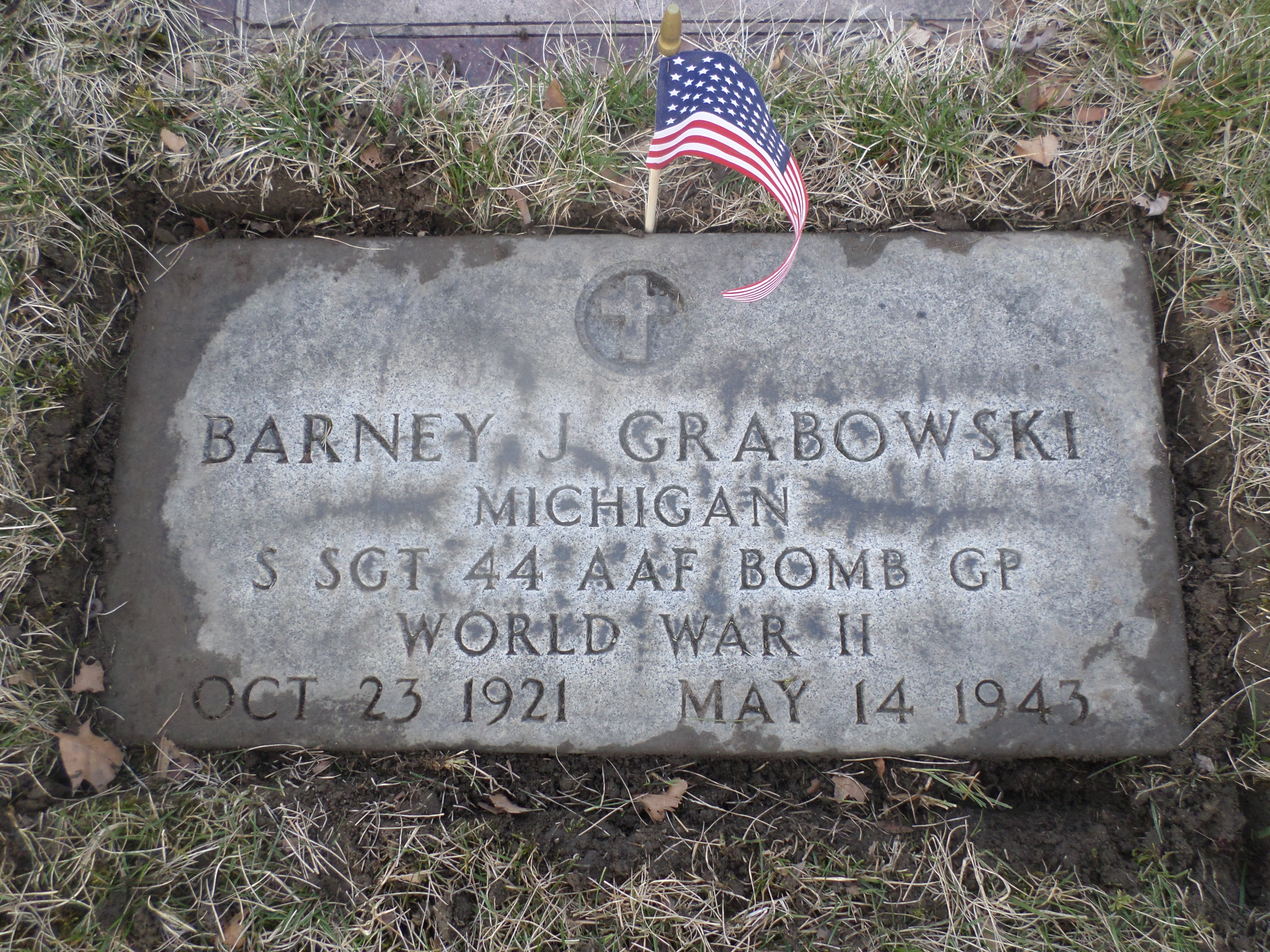Gunner S/Sgt. Barney J. Grabowski KIA
Hometown: Detroit Michigan
Squadron: 67th 44th Bomb Group
Service# 20641515
Awards: Air Medal with 3 Oak Leaf Clusters, Purple Heart
Pilot Capt. Chester L. J. Phillips KIA
MACR 2748
Target: Kiel, Germany
Mission Date: 14-May-43
Serial Number: #41-23807
Aircraft Model B-24
Aircraft Letter:
Aircraft Name: Little Beaver
Location: Germany
Cause: Flak
Crew of 10 5KIA 1MIA/KIA 4POW
The primary target area was the center of the Krupp Submarine Building Works at Kiel. We had 21 aircraft ordered to follow B-17 formations who were to drop high explosives and we were to bomb with both 100-lb. and 500-lb. cluster incendiaries or matchsticks, as they were called. The intent was to set fire to the rubble caused by the earlier bombs. This group had only 17 B-24s in their formation when it arrived at the target, following 109 Fortresses. It was the toughest test to date, with the following statistics: 21 enemy aircraft destroyed, 13 probables and 1 damaged. However, the 44th lost 5, 1 was abandoned, 9 damaged, and 12 men wounded and 51 MIA. For this successful mission, the Group was awarded its first of two unit citations.
This mission was a maximum effort but only three 67th crews could be scraped together. SUZY- Q was being repaired so the third crew was not only “patched” together, it was forced to fly a replacement aircraft named MISS DELORES. T/Sgt. John L. Susan relates his experiences aboard this ship on this mission: “We tried to overtake the B-17s and get above them but the chase was futile. We could not catch them even though we were faster. When we got to the target, we had reached a good altitude but the B-17s were still ahead and above us. The German gunners had a good track on the B-17s and the B-24s were coming in on the same track – and we took on a lot of flak.
The third of the three 67th Squadron aircraft and crews to go down this day was the one piloted by Captain Chester “George” Phillips. Sgt. Michael J. Denny, engineer on LITTLE BEAVER, wrote to lst Sergeant Robert Ryan from his POW camp and he included this information: “Chubby Hill, Glaubitz, Forehand, and myself are the only ones who got out OK. Glaubitz was hit pretty badly, still in hospital in pretty bad shape...Lt. Roach went down before we did – all dead but Kissinger. Brown went down about the same time that we did – all OK but little Klingler, Millhousen, and some new boy (Cate). “We were hit after we left the target. Two bursts in the back end, also knocked out one engine; then a burst in back of our navigator [Thomas E. Bartmess]. The entire inside of the flight deck was a mass of flames. It must have hit the hydraulic fluid in the accumulator positioned there. We went into a flat spin – had a Hell of a time standing on my feet and putting on my parachute. Tried to put out the fire, but was impossible. Could not get doors [bomb bay doors] open so I had to fight my way back to the rear windows to get out. Bailed out at about 800 feet. Was the last one to leave the plane, and saw it crash and burn.” S/Sgt. Charles C. Forehand states, “I remember Tommy Bartmess well – he was a very good officer and navigator. He led us over enemy territory for 22 raids and back. We were looking forward to making the 25th mission soon and coming home. The day we were shot down, the anti-aircraft flak was very heavy and accurate, fighters were everywhere we looked. I was flying as waist gunner that day and we were hit by flak, were on fire. After that, things went so fast I don’t know what went on in the front of the plane. That night a German officer told me that three crew members survived, but I never saw any of them or heard from any of them. I was captured as soon as I hit the ground and was a POW for two years.”Lt. William E. Hill, bombardier, included this bit in a letter dated 29 May 1943 that he sent home from his POW camp: “I suppose by this time you know I am a POW. Went on one mission too many this time. I am the only officer from my crew alive, plus three enlisted men – four out often! A 20-mm cannon shell exploded right in the nose of plane just behind me. I believe having a steel helmet on my head saved my life. Flames broke out immediately and the plane went into a flat spin. My navigator [Bartmess] was first to bail out and I followed. He landed in the water, but was caught in shrouds of parachute and drowned. Fortunately, I stayed with the plane about 3 minutes longer and landed on the beach. Was almost knocked cold by a blow on my forehead as chute opened and again when I landed. However, came out of it all with only a scratch on forehead, sore spine for a few days and a little shock. Germans treat us fine and we have plenty to eat.” Captain Phillips, the pilot, was killed by a flak burst, shortly after leaving the target. This was probably the same flak burst described by Lt. Hill. lst Lt. Wilborn, co-pilot, was last seen standing on the flight deck, and could have had time to bail out, but he did not survive for reasons unknown. With the loss of these three planes, the 67th Squadron was left with only one aircraft and it was being overhauled in Northern Ireland – and one make-shift crew!
Little Beaver Crew
Capt. Chester L. J. Phillips Pilot
1st/Lt. Everett W. Wilborn Jr. Co Pilot
1st/Lt. Thomas E. Bartmess Navigator KIA
1st/Lt. William E. Hill Bombardier POW
T/Sgt. Michael J. Denny Engineer POW
T/Sgt. George B. Price Radio Op. MIA/KIA
S/Sgt. Gaylord F. Hubbard Gunner KIA
S/Sgt. Dale A. Glaubitz Gunner POW
S/Sgt. Edward W. Phillips Gunner KIA
S/Sgt. Charles C. Forehand Gunner POW
S/Sgt. Barney J. Grabowski Gunner KIA
Gunner S/Sgt. Barney J. Grabowski KIA
Hometown: Detroit Michigan
Squadron: 67th 44th Bomb Group
Service# 20641515
Awards: Air Medal with 3 Oak Leaf Clusters, Purple Heart
Pilot Capt. Chester L. J. Phillips KIA
MACR 2748
Target: Kiel, Germany
Mission Date: 14-May-43
Serial Number: #41-23807
Aircraft Model B-24
Aircraft Letter:
Aircraft Name: Little Beaver
Location: Germany
Cause: Flak
Crew of 10 5KIA 1MIA/KIA 4POW
The primary target area was the center of the Krupp Submarine Building Works at Kiel. We had 21 aircraft ordered to follow B-17 formations who were to drop high explosives and we were to bomb with both 100-lb. and 500-lb. cluster incendiaries or matchsticks, as they were called. The intent was to set fire to the rubble caused by the earlier bombs. This group had only 17 B-24s in their formation when it arrived at the target, following 109 Fortresses. It was the toughest test to date, with the following statistics: 21 enemy aircraft destroyed, 13 probables and 1 damaged. However, the 44th lost 5, 1 was abandoned, 9 damaged, and 12 men wounded and 51 MIA. For this successful mission, the Group was awarded its first of two unit citations.
This mission was a maximum effort but only three 67th crews could be scraped together. SUZY- Q was being repaired so the third crew was not only “patched” together, it was forced to fly a replacement aircraft named MISS DELORES. T/Sgt. John L. Susan relates his experiences aboard this ship on this mission: “We tried to overtake the B-17s and get above them but the chase was futile. We could not catch them even though we were faster. When we got to the target, we had reached a good altitude but the B-17s were still ahead and above us. The German gunners had a good track on the B-17s and the B-24s were coming in on the same track – and we took on a lot of flak.
The third of the three 67th Squadron aircraft and crews to go down this day was the one piloted by Captain Chester “George” Phillips. Sgt. Michael J. Denny, engineer on LITTLE BEAVER, wrote to lst Sergeant Robert Ryan from his POW camp and he included this information: “Chubby Hill, Glaubitz, Forehand, and myself are the only ones who got out OK. Glaubitz was hit pretty badly, still in hospital in pretty bad shape...Lt. Roach went down before we did – all dead but Kissinger. Brown went down about the same time that we did – all OK but little Klingler, Millhousen, and some new boy (Cate). “We were hit after we left the target. Two bursts in the back end, also knocked out one engine; then a burst in back of our navigator [Thomas E. Bartmess]. The entire inside of the flight deck was a mass of flames. It must have hit the hydraulic fluid in the accumulator positioned there. We went into a flat spin – had a Hell of a time standing on my feet and putting on my parachute. Tried to put out the fire, but was impossible. Could not get doors [bomb bay doors] open so I had to fight my way back to the rear windows to get out. Bailed out at about 800 feet. Was the last one to leave the plane, and saw it crash and burn.” S/Sgt. Charles C. Forehand states, “I remember Tommy Bartmess well – he was a very good officer and navigator. He led us over enemy territory for 22 raids and back. We were looking forward to making the 25th mission soon and coming home. The day we were shot down, the anti-aircraft flak was very heavy and accurate, fighters were everywhere we looked. I was flying as waist gunner that day and we were hit by flak, were on fire. After that, things went so fast I don’t know what went on in the front of the plane. That night a German officer told me that three crew members survived, but I never saw any of them or heard from any of them. I was captured as soon as I hit the ground and was a POW for two years.”Lt. William E. Hill, bombardier, included this bit in a letter dated 29 May 1943 that he sent home from his POW camp: “I suppose by this time you know I am a POW. Went on one mission too many this time. I am the only officer from my crew alive, plus three enlisted men – four out often! A 20-mm cannon shell exploded right in the nose of plane just behind me. I believe having a steel helmet on my head saved my life. Flames broke out immediately and the plane went into a flat spin. My navigator [Bartmess] was first to bail out and I followed. He landed in the water, but was caught in shrouds of parachute and drowned. Fortunately, I stayed with the plane about 3 minutes longer and landed on the beach. Was almost knocked cold by a blow on my forehead as chute opened and again when I landed. However, came out of it all with only a scratch on forehead, sore spine for a few days and a little shock. Germans treat us fine and we have plenty to eat.” Captain Phillips, the pilot, was killed by a flak burst, shortly after leaving the target. This was probably the same flak burst described by Lt. Hill. lst Lt. Wilborn, co-pilot, was last seen standing on the flight deck, and could have had time to bail out, but he did not survive for reasons unknown. With the loss of these three planes, the 67th Squadron was left with only one aircraft and it was being overhauled in Northern Ireland – and one make-shift crew!
Little Beaver Crew
Capt. Chester L. J. Phillips Pilot
1st/Lt. Everett W. Wilborn Jr. Co Pilot
1st/Lt. Thomas E. Bartmess Navigator KIA
1st/Lt. William E. Hill Bombardier POW
T/Sgt. Michael J. Denny Engineer POW
T/Sgt. George B. Price Radio Op. MIA/KIA
S/Sgt. Gaylord F. Hubbard Gunner KIA
S/Sgt. Dale A. Glaubitz Gunner POW
S/Sgt. Edward W. Phillips Gunner KIA
S/Sgt. Charles C. Forehand Gunner POW
S/Sgt. Barney J. Grabowski Gunner KIA
Sponsored by Ancestry
Advertisement
Records on Ancestry
Sponsored by Ancestry
Advertisement





